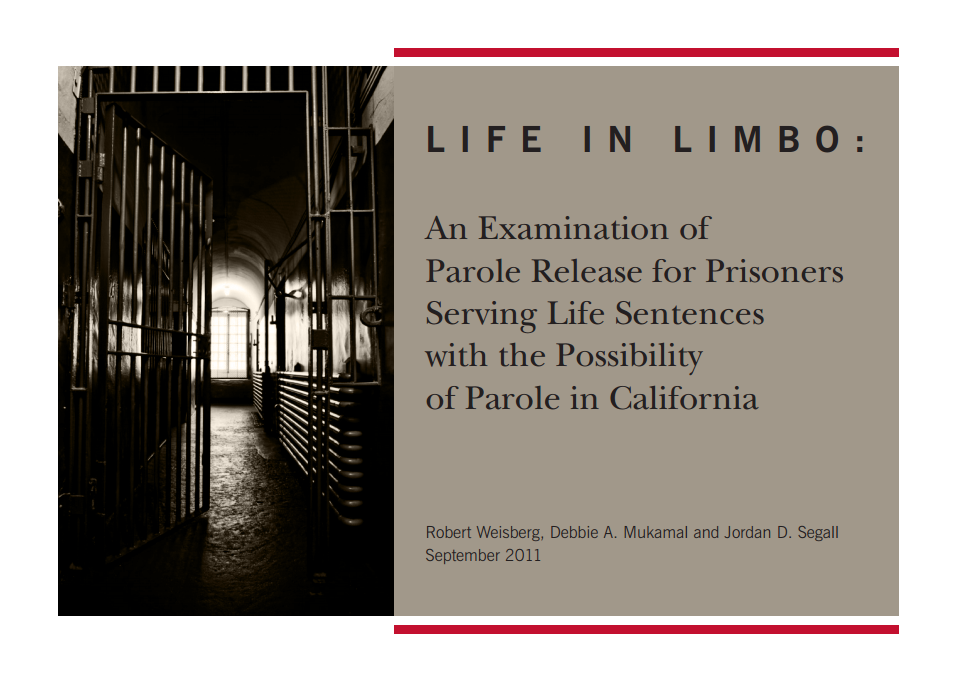Stanford Criminal Justice Center Issues First Major Study of California Prisoners Serving Life Sentences with Possibility of Parole
Preliminary data shows many barriers to parole, while recidivism low among lifers who are deemed suitable for parole
Stanford, Calif., September 15, 2011— The Stanford Criminal Justice Center has released the first rigorous empirical study of the 32,000 prisoners serving life sentences with the possibility of parole in California called, “Life After Limbo: An Examination of Parole Release for Prisoners Serving Life Sentences with the Possibility of Parole in California.”

The study examines the lifer population over the last two decades, analyzing the growth rate and demographic nature of the population; the process by which inmates serving life sentences are considered for parole release; the parole grant rate over time; and the risk of lifers recommitting crimes if paroled. It also provides initial findings from comprehensive analysis of transcripts from 450 Parole Board hearings on lifersuitability conducted between 2007 and 2010.
“California has more inmates serving life than any other state,” said Robert Weisberg, faculty co-director of the Stanford Criminal Justice Center and co-author of the study. “One-fifth of the state’s inmates are currently serving life sentences with the possibility of parole and once the public safety realignment legislation goes into effect in October, the proportion of the inmate population doing life will only increase.”
“The impetus for our research was to better understand the implications of important developments in the parole review process,” said co-author Debbie Mukamal, executive director of the Stanford Criminal Justice Center. “And to provide much-needed insight about a significant, growing portion of our state prison population to policymakers.”
Mukamal explained that in 2008, Marsy’s Law (also known as Proposition 9) gave victims additional rights to participate in parole hearings and the law greatly extended the time between hearings once a lifer is denied parole by the Board. Moreover that same year, she said, the California Supreme Court clarified that the relevant standard for the Board to use in considering whether to release an inmate serving a life sentence with the possibility of parole is whether the prisoner is a current threat to public safety.
“The California Supreme Court clearly ruled that while the commitment offense is probative, in and of itself, it cannot serve as the sole reason to deny parole,” Mukamal said. “But newly proposed legislation–SB 391–would authorize the Parole Board to base its decision to deny parole solely upon the circumstances of the commitment offense. And that would directly overrule the California Supreme Court opinion,” she said.
Further complicating matters, California is one of six states that has generally abolished discretionary parole and moved towards determinate sentences but whose parole board retains authority for parole release decisions over prisoners serving life sentences. And, California is one of three states whose governors have the authority to review and reverse the Board’s decisions.
Among the report’s most significant findings are the following:
- The size of the lifer population has increased as a percentage of the overall California prison population from eight percent in 1990 to 20 percent in 2010. Most individuals serving life sentences with the possibility of parole are serving time for first- or second-degree murder. The average number of years served by a prisoner serving a life sentence with the possibility of parole is 20 years.
- A prisoner serving a life sentence with the possibility of parole now stands an 18 percent chance of being granted parole by the Board of Parole Hearings. The grant rate has fluctuated over the last 30 years–nearing zero percent at times and never arising above 20 percent.
- The likelihood of a lifer convicted of murder being granted parole by the Board and not having the decision reversed by the Governor is–and always has been–slim. In 2010, the probability was approximately six percent.
- While data is limited, interim information suggests that the incidence of commission of serious crimes by recently released lifers has been minuscule, and as compared to the larger inmate population, recidivism risk–at least among those deemed suitable for release by both the Board and the Governor–is minimal.
About the Stanford Criminal Justice Center
The Stanford Criminal Justice Center (SCJC) serves as Stanford’s vehicle for promoting and coordinating the study of criminal law and the criminal justice system, including legal and interdisciplinary research, policy analysis, curriculum development, and preparation of law students for careers in criminal law. The center is headed by faculty co-directors Robert Weisberg and Joan Petersilia, and executive director Debbie Mukamal. SCJC’s areas of interest include criminal trial practice and procedure, institutional examination of the police and correctional systems, social science study of the origins of criminal behavior and methods of punishment, and criminal legislation and enforcement in areas ranging from drug crimes to federal white collar crimes. One major goal of the center is to encourage collaborative criminal justice policy development at the national, state, regional, and local levels by: promoting public/private partnerships between different levels of government in the criminal justice arena; creating opportunities for the use of social science research to aid in the development and implementation of empirically-validated, data-driven criminal justice programs and policies; and serving as a public service consultant to public officials at all levels of government.
